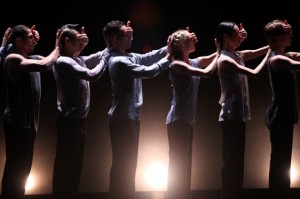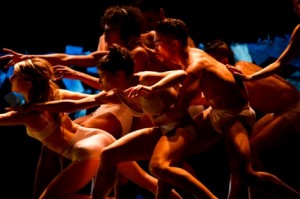Cedar Lake Contemporary Ballet
Jacob’s Pillow Dance
July 3-7, 2013
Review by Seth Rogovoy
(BECKET, Mass.) – New York-based Cedar Lake Contemporary Ballet is in residence at Jacob’s Pillow Dance through Sunday, July 7, with a wildly diverse, three-dance program that serves to showcase the brilliance and versatility of the company’s dancers, who can seemingly be called upon to do anything — social dancing; improvising; beatboxing; ballet, of course; acting; running; leaping; or even just standing still. And to make it all look beautiful and compelling at the same time.
The evening’s highlight is Grace Engine, choreographed by Crystal Pite – artistic director of Kidd Pivot, who won the Jacob’s Pillow Dance Award in 2012 — for the company last year. The work is stark, minimalist, with a distinct taste of film noir (an observation I owe to choreographer Sandra Burton, whom I promised to credit for such).
Ominous footsteps loom large in the electronic soundscape created by Owen Belton, as does the sound of an approaching railroad. The sound seems to awaken a human figure sleeping on the “tracks,” here represented by a thin rectangle of light on the black floor. The man, dressed like a commuter, comes alive in a frenzy of action as dark, anonymous bodies fly by him.
The dancing here is fluid and miraculous, with energy flowing through one dancer to the next, so movement doesn’t begin or end at any particular person. The corps assembles several times like a horde of drugged office workers (zombies is probably the more apt, if overused, comparison these days), moving in shuffling lockstep. Trains come and go; small groups of dancers assemble for duets and quartets; there are stylized fights, perhaps representing the law of the jungle, or competition, which lies just below the surface of the workplace.
Grace Engine was an engrossing dance, lit starkly like David Bowie’s 1978 “Isolar” or “white-light” tour. As the first of three dances in the program, it set the bar high – so high that what came next was bound to disappoint.
The concluding number, Necessity, Again, by the Norwegian Jo Stromgren, posited a battle between two French cultural icons: the jazzy pop singer Charles Aznavour and the literary theorist Jacques Derrida, the former representing passion and the latter cold reason. It was a bit of an arch setup, with Derrida’s intellectual hijinks (we heard him lecturing on a recording) meant to provoke bafflement, with the dancers standing still while he talked about “deconstruction” and “necessity.” Then whenever Aznavour would sing in his excessive manner, the dancers would break out of their stillness, come alive, dance, and crumple up and toss the hundreds of pieces of paper that hung on a laundry line, presumably representing Derrida and his intellectual ilk.
The mercifully short Tuplet, by Alexander Ekman, was ostensibly a study of rhythm in all aspects of life. It had all the sophistication and innovation of my five-year-old’s Kindermusik class. Then again, my five-year-old is now 20 and composes and produces EDM (electronic dance music) hits, so maybe when Tuplet grows up it, too, will amount to something.


